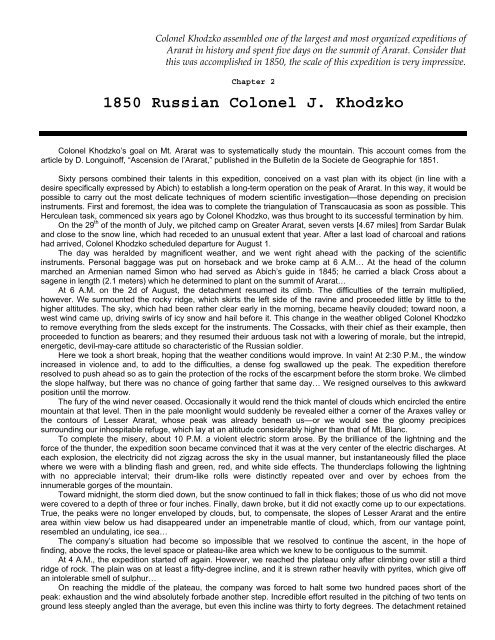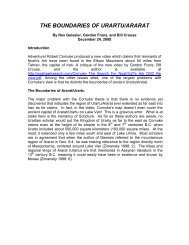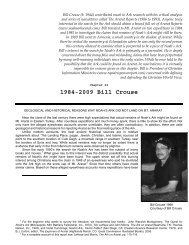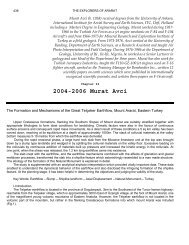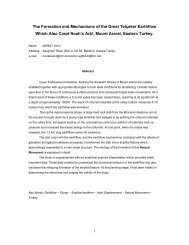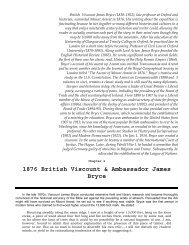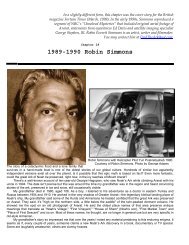1850 Russian Colonel J Khodzko
1850 Russian Colonel J. Khodzko - Noah's Ark Search
1850 Russian Colonel J. Khodzko - Noah's Ark Search
- No tags were found...
Create successful ePaper yourself
Turn your PDF publications into a flip-book with our unique Google optimized e-Paper software.
<strong>Colonel</strong> <strong>Khodzko</strong> assembled one of the largest and most organized expeditions of<br />
Ararat in history and spent five days on the summit of Ararat. Consider that<br />
this was accomplished in <strong>1850</strong>, the scale of this expedition is very impressive.<br />
Chapter 2<br />
<strong>1850</strong> <strong>Russian</strong> <strong>Colonel</strong> J. <strong>Khodzko</strong><br />
<strong>Colonel</strong> <strong>Khodzko</strong>’s goal on Mt. Ararat was to systematically study the mountain. This account comes from the<br />
article by D. Longuinoff, “Ascension de l’Ararat,” published in the Bulletin de la Societe de Geographie for 1851.<br />
Sixty persons combined their talents in this expedition, conceived on a vast plan with its object (in line with a<br />
desire specifically expressed by Abich) to establish a long-term operation on the peak of Ararat. In this way, it would be<br />
possible to carry out the most delicate techniques of modern scientific investigation—those depending on precision<br />
instruments. First and foremost, the idea was to complete the triangulation of Transcaucasia as soon as possible. This<br />
Herculean task, commenced six years ago by <strong>Colonel</strong> <strong>Khodzko</strong>, was thus brought to its successful termination by him.<br />
On the 29 th of the month of July, we pitched camp on Greater Ararat, seven versts [4.67 miles] from Sardar Bulak<br />
and close to the snow line, which had receded to an unusual extent that year. After a last load of charcoal and rations<br />
had arrived, <strong>Colonel</strong> <strong>Khodzko</strong> scheduled departure for August 1.<br />
The day was heralded by magnificent weather, and we went right ahead with the packing of the scientific<br />
instruments. Personal baggage was put on horseback and we broke camp at 6 A.M… At the head of the column<br />
marched an Armenian named Simon who had served as Abich’s guide in 1845; he carried a black Cross about a<br />
sagene in length (2.1 meters) which he determined to plant on the summit of Ararat…<br />
At 6 A.M. on the 2d of August, the detachment resumed its climb. The difficulties of the terrain multiplied,<br />
however. We surmounted the rocky ridge, which skirts the left side of the ravine and proceeded little by little to the<br />
higher altitudes. The sky, which had been rather clear early in the morning, became heavily clouded; toward noon, a<br />
west wind came up, driving swirls of icy snow and hail before it. This change in the weather obliged <strong>Colonel</strong> <strong>Khodzko</strong><br />
to remove everything from the sleds except for the instruments. The Cossacks, with their chief as their example, then<br />
proceeded to function as bearers; and they resumed their arduous task not with a lowering of morale, but the intrepid,<br />
energetic, devil-may-care attitude so characteristic of the <strong>Russian</strong> soldier.<br />
Here we took a short break, hoping that the weather conditions would improve. In vain! At 2:30 P.M., the window<br />
increased in violence and, to add to the difficulties, a dense fog swallowed up the peak. The expedition therefore<br />
resolved to push ahead so as to gain the protection of the rocks of the escarpment before the storm broke. We climbed<br />
the slope halfway, but there was no chance of going farther that same day… We resigned ourselves to this awkward<br />
position until the morrow.<br />
The fury of the wind never ceased. Occasionally it would rend the thick mantel of clouds which encircled the entire<br />
mountain at that level. Then in the pale moonlight would suddenly be revealed either a corner of the Araxes valley or<br />
the contours of Lesser Ararat, whose peak was already beneath us—or we would see the gloomy precipices<br />
surrounding our inhospitable refuge, which lay at an altitude considerably higher than that of Mt. Blanc.<br />
To complete the misery, about 10 P.M. a violent electric storm arose. By the brilliance of the lightning and the<br />
force of the thunder, the expedition soon became convinced that it was at the very center of the electric discharges. At<br />
each explosion, the electricity did not zigzag across the sky in the usual manner, but instantaneously filled the place<br />
where we were with a blinding flash and green, red, and white side effects. The thunderclaps following the lightning<br />
with no appreciable interval; their drum-like rolls were distinctly repeated over and over by echoes from the<br />
innumerable gorges of the mountain.<br />
Toward midnight, the storm died down, but the snow continued to fall in thick flakes; those of us who did not move<br />
were covered to a depth of three or four inches. Finally, dawn broke, but it did not exactly come up to our expectations.<br />
True, the peaks were no longer enveloped by clouds, but, to compensate, the slopes of Lesser Ararat and the entire<br />
area within view below us had disappeared under an impenetrable mantle of cloud, which, from our vantage point,<br />
resembled an undulating, ice sea…<br />
The company’s situation had become so impossible that we resolved to continue the ascent, in the hope of<br />
finding, above the rocks, the level space or plateau-like area which we knew to be contiguous to the summit.<br />
At 4 A.M., the expedition started off again. However, we reached the plateau only after climbing over still a third<br />
ridge of rock. The plain was on at least a fifty-degree incline, and it is strewn rather heavily with pyrites, which give off<br />
an intolerable smell of sulphur…<br />
On reaching the middle of the plateau, the company was forced to halt some two hundred paces short of the<br />
peak: exhaustion and the wind absolutely forbade another step. Incredible effort resulted in the pitching of two tents on<br />
ground less steeply angled than the average, but even this incline was thirty to forty degrees. The detachment retained
128 THE EXPLORERS OF ARARAT<br />
this post for three nights and two days (August 3-5), and during that time the wind, accompanied by snow, hail, and<br />
ice, kept up almost without interruption…<br />
<strong>Colonel</strong> <strong>Khodzko</strong> determined to use the morning for the exploration of the peak areas, as well as for the discovery<br />
of an advantageous location for the scientific instruments and for the high camp itself. At 8:45, he started out with the<br />
Cossacks, and a quarter of an hour later he reached the upper-level plain… Three peaks dominated. On two of them,<br />
we saw pyramidal formations, made of rocky debris and surmounted with testimonies to the Faith. These had been put<br />
up by some soldiers who, a month before, had voluntarily climbed Ararat under the leadership of one Tchougounkoff,<br />
and who had reached this solitary place on July the 12 th . We rapidly climbed the closest of these summits, and then<br />
proceeded to the second (the eastern summit, which is some thirty feet lower than the western peak climbed by Parrot<br />
in 1829), which Abich had conquered in 1845.<br />
But great was our surprise when, on reaching the top of that peak, we saw before us yet a third summit,<br />
incomparablably higher than the other two and separated by a wide gully. The steep projections of that gully, which<br />
dropped off perpendicularly to a depth of about a sagene and a half [ten and a half feet], made it hard to cross.<br />
Nonetheless, we conquered the obstacle with the aid of the soldiers and, at 10 o’clock in the morning (it was the Feast<br />
of the Transfiguration), Messrs. <strong>Khodzko</strong>, Khanykoff and their compatriots stood on the highest peak of Greater Ararat.<br />
Previously, only Parrot and Spasski had succeeded in doing this, and they had come up by the opposite slope<br />
[Kohdzko apparently was not aware of Abich’s accent and potentially a few others].<br />
First and foremost, we set about to erect the Cross. When our guide Simon had been otherwise occupied and—<br />
characteristically—at the places where the climb had been most treacherous, the Cross had been put in the safekeeping<br />
of Cossack Dokhnoff. When he reached the spot, that man fell on his knees, prostrated himself three times<br />
before the sign of our Redemption, and forthwith went to work to plant it in the ground. Then we, his helpers, gathered<br />
around this Christian symbol, which had just been placed on the summit of the biblical mount, and concluded the<br />
ceremony with a fervent prayer…<br />
Before his final departure from the summit area, <strong>Colonel</strong> <strong>Khodzko</strong> had his men build a snow pyramid a sagene in<br />
height [<strong>Russian</strong> measure of length equal to about seven English feet] where his camp had been, and on it the Cross<br />
was raised with a bronze plaque affixed. The inscription read:<br />
IN THE YEAR <strong>1850</strong><br />
FROM THE 6 TH TO THE 18 TH OF AUGUST<br />
UNDER THE PROPITIOUS REIGN OF<br />
EMPEROR NICHOLAS I<br />
AND THE CAUCASIAN LIEUTENANCY OF<br />
PRINCE WORONTSOFF<br />
THE ASCENT OF GREATER ARARAT WAS<br />
ACHIEVED BY COLONEL KHODZKO, WHO<br />
DIRECTED THE TRIANGULATION,<br />
N. KHANYKOFF, J. ALEXANDROFF, A. MORITZ, J. SCHAROYAN AND SIXTY SOLDIERS.


